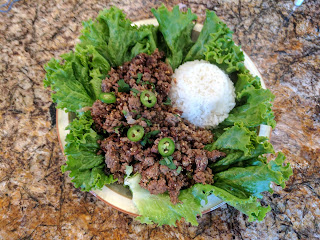My personal culinary challenge -- Around the World in 80 Dishes -- has figuratively taken me around the world. I have made a main course based on the cuisine of countries From Andorra to Australia, as well as many places in between. The next challenge takes me to a region where I have not a challenge ... southeast Asia. The next challenge requires me to make a main course from the country of Laos. But, first, a few quick notes about Laotian cuisine.
While Laos is nestled in between Vietnam, Cambodia and Thailand, its cuisine sets itself apart from its neighbors. Laotian cuisine tends to be spicier than Cambodian and Vietnamese cuisine, due to the use of local chiles. A cornerstone of many dishes is the use of sticky rice, which could be served with breakfast, lunch and dinner. Those chiles and fresh herbs -- including galangal, kaffir lime leaves, and lemongrass -- contribute pungent, spicy notes to dishes.
Many of those dishes may be more familiar to people than most realize. Over the years, many Lao emigrated from their home to neighboring countries, particularly Thailand. Some dishes that are assumed to be Thai, are actually Lao in origin. Indeed, in southeast Asia, there is a shared heritage between the Thais and Lao, as well as the Vietnamese and Cambodians, that many dishes of each country's cuisine share common characteristics of those prepare by cooks in the countries.
While Laos is nestled in between Vietnam, Cambodia and Thailand, its cuisine sets itself apart from its neighbors. Laotian cuisine tends to be spicier than Cambodian and Vietnamese cuisine, due to the use of local chiles. A cornerstone of many dishes is the use of sticky rice, which could be served with breakfast, lunch and dinner. Those chiles and fresh herbs -- including galangal, kaffir lime leaves, and lemongrass -- contribute pungent, spicy notes to dishes.
Many of those dishes may be more familiar to people than most realize. Over the years, many Lao emigrated from their home to neighboring countries, particularly Thailand. Some dishes that are assumed to be Thai, are actually Lao in origin. Indeed, in southeast Asia, there is a shared heritage between the Thais and Lao, as well as the Vietnamese and Cambodians, that many dishes of each country's cuisine share common characteristics of those prepare by cooks in the countries.
MAIN COURSE
Whenever I select a main course as part of my Around the World in 80 Dishes culinary challenge, my research often turns up what is labelled the "national dish" or "official dish" of a country. However, what really interests me is not what someone or some people call a country's "national dish," but what is commonly eaten by the people of that country.
In the case of Laos, that dish would be Larb (or Laab). Generally, Laotian larb is a meat salad prepared with vegetables, fish sauce, lime and chiles served on lettuce with even more vegetables. The result is a spicy, slightly sour dish that sets it apart from other larb dishes, such as those prepared in northern Thailand. I have made the Thai version in the past using pork, as well as a version with shrimp, so I have a basic idea as to how to prepare the dish. (It's kind of like cheating, but in a delicious way.)
Larb can be made with any protein, such as beef and chicken. Beef is difficult to find in Laos, but it seemed appropriate given that the dish is often used to mark special occasion such as a housewarming, the birth of child or a holiday. If I was in Laos, I would more than likely have the dish made with chicken, pork or duck. (All of which sounds delicious, by the way.)
Larb can be made with any protein, such as beef and chicken. Beef is difficult to find in Laos, but it seemed appropriate given that the dish is often used to mark special occasion such as a housewarming, the birth of child or a holiday. If I was in Laos, I would more than likely have the dish made with chicken, pork or duck. (All of which sounds delicious, by the way.)
BEEF LARB
Recipe from Bois de Jasmine
Serves 4 as appetizer, 2 as main dish
Ingredients (for the dish):
1 pound ground beef
4 shallots (2 sliced in thin rounds, 2 minced)
5 spring onions, sliced in thin rounds
2 garlic cloves, sliced in thin rounds
2 hot chile peppers, sliced in thin rounds
1 teaspoon of sugar
1 tablespoon of fish saucea
2 tablespoons of khao khua (roasted rice powder)
Ingredients (for the garnish):
Herbs (spring onions, mint, cilantro)
Lettuce leaves
Cucumber, sliced
Chiles, sliced (to taste)
1 lime, sliced
String beans (optional)
Directions:
1. Make the khao khua. Put two tablespoons of rice into a frying pan without oil and toast, stirring frequently, over medium low heat until it turns brown and smells well-toasted. Remove from the stove adn crush into powder.
2. Make the Larb. Heat 1 tablespoon of oil in a frying pan, then add the sliced shallots, garlic, spring onions and chiles. When they have browned, add the beef, sugar and fish sauce. Once the beef is well cooked, add more salt, lime juice and adjust the seasonings. Set aside and let cool.
3. Finish the dish. Toss beef with herbs, minced shallots and roasted rice powder. Serve with garnishes on a side.
* * *
This challenge was inspired by my desire to make larb, and, it was -- like my prior efforts -- a very delicious dish. The relative simplicity of the dish makes it one that could be made quickly after a busy day at work. It is one that I will make again ... and again ... and again. Until next time ...
ENJOY!



